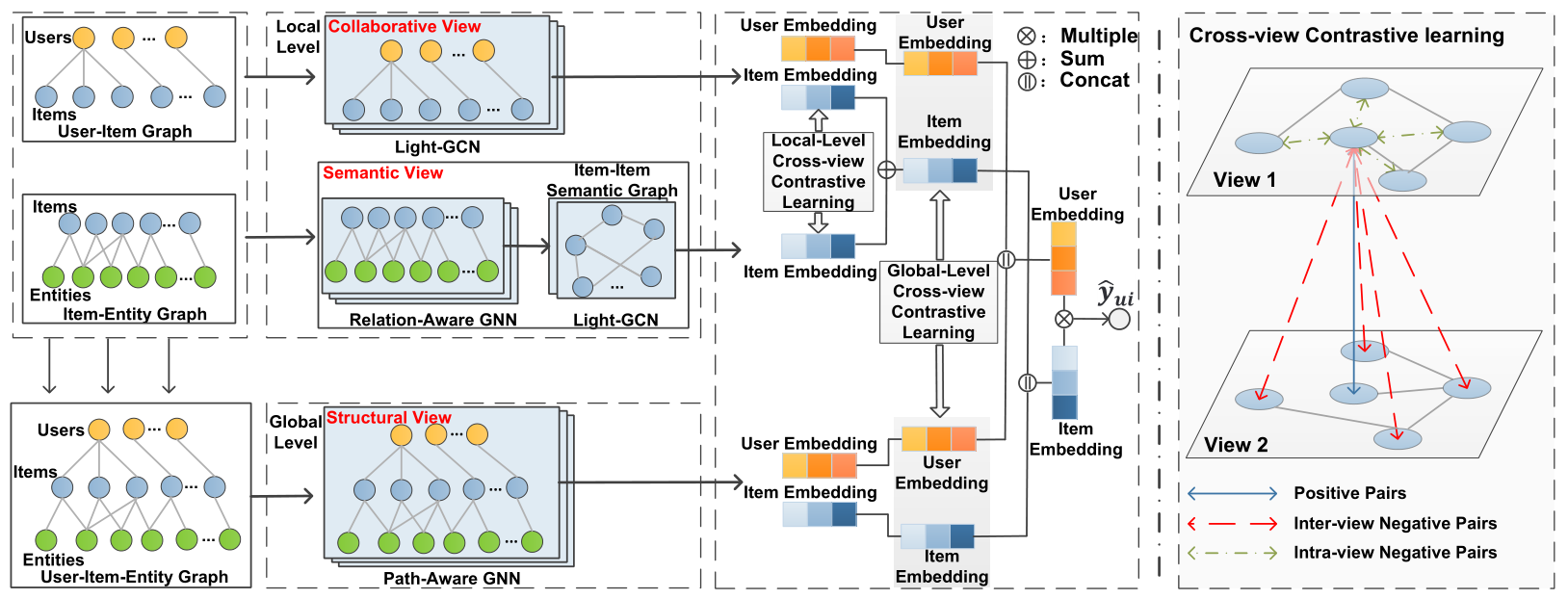MCCLK¶
Introduction¶
Title: Multi-level Cross-view Contrastive Learning for Knowledge-aware Recommender System
Authors: Ding Zou, Wei Wei, Xian-Ling Mao, Ziyang Wang, Minghui Qiu, Feida Zhu, Xin Cao
Abstract: Knowledge graph (KG) plays an increasingly important role in recommender systems. Recently, graph neural networks (GNNs) based model has gradually become the theme of knowledge-aware recommendation (KGR). However, there is a natural deficiency for GNN-based KGR models, that is, the sparse supervised signal problem, which may make their actual performance drop to some extent. Inspired by the recent success of contrastive learning in mining supervised signals from data itself, in this paper, we focus on exploring the contrastive learning in KG-aware recommendation and propose a novel multi-level cross-view contrastive learning mechanism, named MCCLK. Different from traditional contrastive learning methods which generate two graph views by uniform data augmentation schemes such as corruption or dropping, we comprehensively consider three different graph views for KG-aware recommendation, including global-level structural view, local-level collaborative and semantic views. Specifically, we consider the user-item graph as a collaborative view, the item-entity graph as a semantic view, and the user-item-entity graph as a structural view. MCCLK hence performs contrastive learning across three views on both local and global levels, mining comprehensive graph feature and structure information in a self-supervised manner. Besides, in semantic view, a k-Nearest-Neighbor (kNN) item-item semantic graph construction module is proposed, to capture the important item-item semantic relation which is usually ignored by previous work. Extensive experiments conducted on three benchmark datasets show the superior performance of our proposed method over the state-of-the-arts.

Running with RecBole¶
Model Hyper-Parameters:
embedding_size (int): The embedding size of users, items, entities and relations. Defaults to64.reg_weight (float): The L2 regularization weight. Defaults to1e-5.n_hops (int): The number of context hops in GCN layer. Defaults to2.node_dropout_rate (float): The node dropout rate in GCN layer. Defaults to0.1.mess_dropout_rate (float): The message dropout rate in GCN layer. Defaults to0.1.lightgcn_layer (int): The number of LightGCN layer. Defaults to2.item_agg_layer (int): The number of item aggregation layer. Defaults to1.alpha (float): The local-level contrastive loss weight. Defaults to0.2.beta (float): The contrastive loss weight. Defaults to0.1.k (int): The topk parameter used in building a k-NN item-item semantic graph. Defaults to10.lambda_coeff (float): The coefficient when updating k-NN item-item semantic graph. Defaults to0.5.temperature (float): The temperature parameter used in loss calculation. Defaults to0.8.build_graph_separately (bool): Whether user a separate GCN to build item-item graph. Defaults toTrue.loss_type (str): The loss type used in this model. Defaults to'BPR'. Range in['BPR', 'BCE'].
A Running Example:
Write the following code to a python file, such as run.py
from recbole.quick_start import run_recbole
run_recbole(model='MCCLK', dataset='ml-100k')
And then:
python run.py
Tuning Hyper Parameters¶
If you want to use HyperTuning to tune hyper parameters of this model, you can copy the following settings and name it as hyper.test.
learning_rate choice [1e-4,1e-3,5e-3]
node_dropout_rate choice [0.1,0.3,0.5]
mess_dropout_rate choice [0.0,0.1]
build_graph_separately choice [True, False]
Note that we just provide these hyper parameter ranges for reference only, and we can not guarantee that they are the optimal range of this model.
Then, with the source code of RecBole (you can download it from GitHub), you can run the run_hyper.py to tuning:
python run_hyper.py --model=[model_name] --dataset=[dataset_name] --config_files=[config_files_path] --params_file=hyper.test
For more details about Parameter Tuning, refer to Parameter Tuning.
If you want to change parameters, dataset or evaluation settings, take a look at